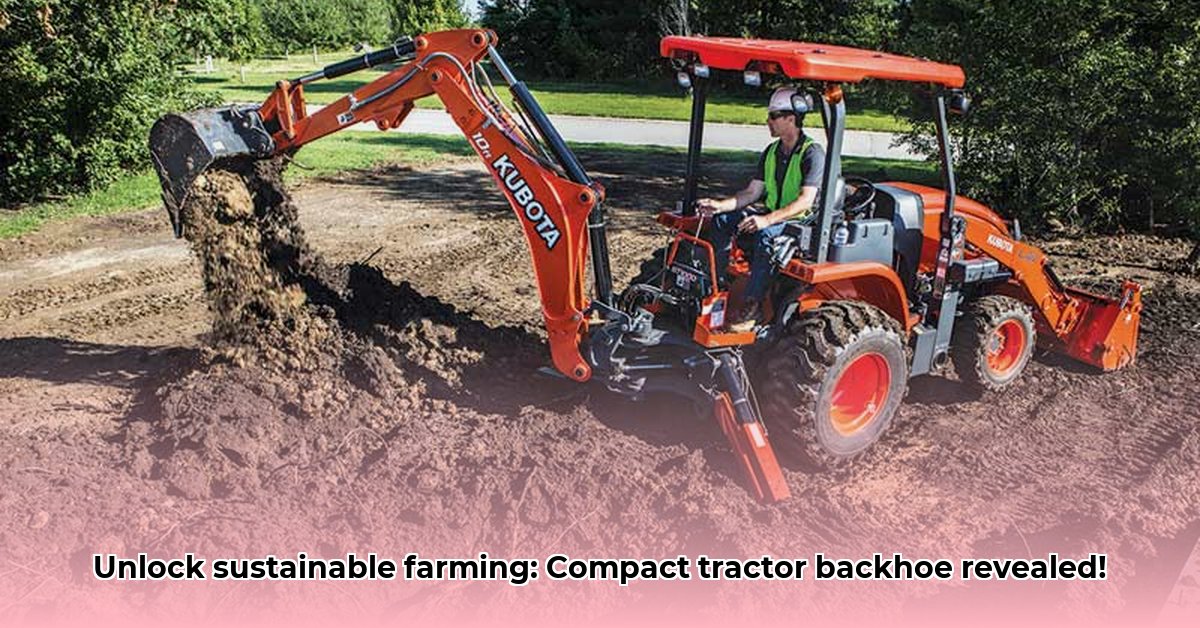
Finding the right compact tractor with a backhoe is a crucial investment for smallholder farmers aiming for both productivity and environmental responsibility. This guide provides a step-by-step approach to selecting a machine that meets your needs while minimizing your environmental impact. For more information on Kubota models, check out this helpful resource: Kubota Compact Tractors.
Understanding Your Farming Needs: A Personalized Approach
Before considering horsepower or hydraulic systems, thoroughly assess your farm's unique requirements. This crucial first step ensures you choose a tractor that's perfectly sized for your operation and avoids unnecessary expenses. Consider these key factors:
Land Size: How many acres do you need to cultivate? Larger farms require more powerful tractors, while smaller plots benefit from more compact, fuel-efficient models.
Soil Type: Do you have heavy clay, sandy loam, or another type of soil? Heavier soils necessitate higher horsepower for effective tilling.
Workload: What tasks will the tractor perform? Will it primarily be used for digging post holes, trenching, land grading, or a combination of tasks? A diverse workload might require a more versatile machine with various attachment capabilities.
Key Features for Sustainable Compact Tractors
Now, let's examine the essential features that contribute to both efficient farming practices and environmental sustainability.
Engine Power (Horsepower): This determines the tractor's pulling power; higher horsepower is needed for heavy soils and larger fields. However, avoid overspending on power you won't utilize, as this leads to inefficient fuel consumption.
Fuel Efficiency: This is key to both cost savings and reduced carbon emissions. Modern diesel engines often provide good fuel economy, but compare manufacturers' data on fuel consumption (liters/hour or gallons/hour) to make an informed choice.
Hydraulic System Performance: A robust hydraulic system is critical for smooth and efficient backhoe operation. Consider the lifting capacity and digging depth specifications to ensure they meet your requirements, as a more responsive system enhances precision and reduces effort.
Transmission Type: Hydrostatic transmissions offer smooth operation and precise speed control, ideal for maneuvering in confined spaces. Consider the benefits of this type of transmission if fine control is a priority.
Attachment Versatility: The ability to use various attachments like rippers or augers significantly improves efficiency and sustainability. Choose a tractor compatible with the tools that best suit your unique needs.
Comparing Compact Tractor Models: A Data-Driven Approach
The following table offers a general overview of some popular models. Note that prices and specifications may vary depending on the dealer and specific configurations. Always consult the manufacturer's website for the most up-to-date information.
| Model | Horsepower (Approximate) | Price Range (USD, approximate) | Key Features | Sustainability Highlights |
|---|---|---|---|---|
| Kubota B26 TLB | 26 hp | $25,000 - $30,000 | Durable, reliable, versatile | Good fuel economy, long lifespan, repairability |
| Massey Ferguson GC1725M | 25 hp | $20,000 - $25,000 | User-friendly, generally more affordable | Relatively fuel-efficient |
| KIOTI CS2520 | 25 hp | $22,000 - $27,000 | Powerful hydraulic system | Designed with fuel efficiency in mind |
| Other Models | Varies | Varies | Check manufacturer specifications for detailed information | Consider fuel efficiency, engine type, and overall durability |
Sustainable Farming with Your Compact Tractor: Long-Term Benefits
Investing in a compact tractor isn't just about acquiring machinery; it's about enhancing your farming practices for long-term sustainability. Key advantages include:
Reduced Labor: Automating heavy tasks frees up time and energy for other essential farming activities.
Improved Efficiency: Optimized operations lead to higher crop yields, maximizing resource utilization.
Reduced Fuel Use (with careful selection): Fuel-efficient models minimize operational costs and environmental impact. Proper maintenance further enhances fuel economy.
Remember that responsible disposal and recycling of the tractor at the end of its lifespan are also important considerations for overall sustainability.
Choosing Your Tractor: A Step-by-Step Guide
Follow these steps for a successful purchase:
Assess Your Needs: Thoroughly evaluate your land size, soil type, and planned tasks.
Research Models: Compare specifications, features, and prices from manufacturers and gather feedback from other farmers in your area.
Consider Essential Attachments: Choose a tractor compatible with tools needed to expand its versatility.
Prioritize Fuel Efficiency: Carefully examine fuel consumption ratings to minimize long-term operational costs.
Factor in Long-Term Costs: Include costs for maintenance, repairs, and potential resale value in your budget.
Seek Expert Advice: Consult local agricultural extension services or experienced farmers for recommendations tailored to your specific region.
Choosing the right compact tractor with a backhoe is a significant financial commitment. Take your time to carefully evaluate your individual requirements and prioritize features that promote both efficiency and sustainability. This investment will pay dividends in terms of productivity and environmental responsibility for years to come.